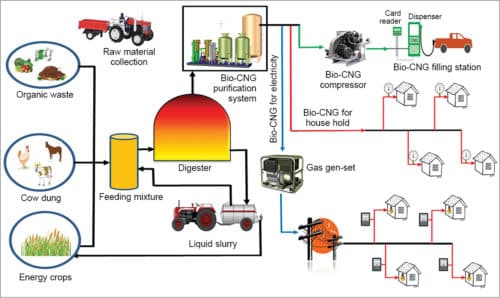Global adoption of bio-CNG depends on several economic, environmental and technical factors.
Transport sector is one of the major contributors to greenhouse gases on the planet. As per UN World Meteorological Organization, global temperatures will rise by 3.5 degree Celsius in this century if considerable measures are not adopted. Nations have been focusing on utilising renewable energy sources as alternative fuel sources to reduce the environmental impact. But questions arise. Upscaling of which source is the most effective alternative?
Could cow dung or vegetable peels be the ultimate answer to this problem?
A recent study by French Institute of Petroleum (IFPEN) has revealed that the biogas sector can contribute to de-carbonising transportation. The study collated carbon footprint data of the complete lifecycle of compressed natural gas (CNG), biomethane, gasoline, diesel and electric vehicles (EVs), and concluded that biomethane is the best option for maintaining air quality. It recommends a mix of biomethane and CNG till 2030 to power vehicles with a climate impact equivalent to that of an EV, as a mid-term solution.
Agricultural residues, food waste, organic municipal waste, bio-waste from industries and so on are common sources of biomass. Raw biogas consisting of methane, carbon-dioxide and such impurities as hydrogen-sulphide and water vapour is produced from biomass in the absence of oxygen, and can be converted into different automobile fuels like bio compressed natural gas (bio-CNG) or compressed biogas (CBG), gasoline, syngas and liquefied biogas.

Among these, bio-CNG offers numerous advantages as a renewable vehicle fuel, such as high calorific value and cost savings over conventional fuels. It is similar to natural gas in terms of composition and properties.
Biogas, when purified to get biomethane by absorbing or scrubbing contaminants and pressurised for storage in high-pressure cylinders, gets upgraded to bio-CNG. Without proper purification, using biogas can lead to erosion of metal parts in vehicles. Purity of bio-CNG reserves in automobiles can be tracked using software and data analysis tools.
In India, there is immense scope for bio-CNG due to abundance of biomass. Built in 2016, the bio-CNG plant at Mahindra World City in Chennai converts hundred per cent of food and kitchen waste generated daily in the city into raw biogas. Bio-CNG thereby produced is utilised for cooking purposes, as a fuel for buses and tractors, as well as to power streetlights in the area.
In 2017, Tata Motors showcased the nation’s first bio-CNG bus at the bio-energy programme, Urja Utsav.
Government policies are further boosting these initiatives. In October 2018, Sustainable Alternative Towards Affordable Transportation (SATAT) scheme was launched by Ministry of Petroleum and Natural Gas under which production of fifteen million tonnes of CBG from 5000 plants is expected by 2023.
Besides this, Galvanising Organic Bio-Agro Resources Dhan (GOBAR-DHAN) scheme, aimed at converting solid waste and cattle dung into compost, fertiliser, biogas and bio-CNG, was announced in Union Budget 2018-19.
Global adoption of bio-CNG depends on several economic, environmental and technical factors. Capital cost for installation of bio-CNG plants is high. Sources for feed materials are not consistent, and refuelling stations are more complicated than conventional ones since high pressure for various components needs to be maintained.
Due to its short driving range, additional fuel cylinders may be required for extending the range. There is a shortage of skilled professionals necessary for the production process in this field. Also, there is a lack of proper standards and regulations in many countries when it comes to installation, operation and maintenance of plants.
However, the plethora of advantages will drive the growth of bio-CNG vehicles, primarily trucks and buses. In Sweden, Bio-CNG is already being used on a large scale to run buses. UK-based John Lewis plans to switch all its heavy delivery trucks to biomethane-powered versions by 2028. Petrol as well as diesel engine driven vehicles can be driven by bio-CNG through retrofitting.
Bio-CNG can help with the problem of solid waste that is dumped in landfills and polluted air due to stubble-burning while simultaneously creating new employment opportunities.
There is a need to create awareness among masses about the benefits of biogas to maximise its use for various purposes including transportation and achieve sustainable development.






